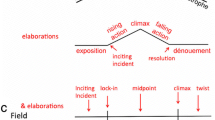Abstract
Contemporary art by its nature has always challenged the viewer and the institutions that support it. Film grew up in a time of political establishments being questioned, rising and falling. Modern music, too, was brought to the masses in a time of political change and learned disobedience. But games, and videogames in particular, are different. Videogames, even though they are the chosen medium of a troubled generation dogged by the political instability of faltering economics, do not attempt at political discontent or relevant social expression on a level even close to other forms. In order for games to fully utilise their status as an art form and challenge the systems around them, their creators should examine the legacy of contemporary art and popular music culture, and not merely try to make video games ‘’fun’’.
Similar content being viewed by others
References
Punk Attitude (2005) Directed by Don Letts [DVD] UK/USA: 3DD Productions, Cactus Three, Fremantle Media.
Hussey, D. (2013). Reading into the Cold War in Video Games. Available from: http://www.playthepast.org/?p=4101 (Accessed on 17.10.2013)
Shank, B. (1994), Dissonant Identities: The Rock’N’Roll Scene in Austin, Texas. Hanover, NH: Wesleyan University Press.
Duchamp, M. (1917). Fountain. [glazed ceramic, ceramic] 61 cm x 36 cm x 48 cm At: Replicas at multiple locations, Indiana University Art Museum, San Francisco Museum of Modern Art, Philadelphia Museum of Art, Tate Modern, London.
Miami Dade College, Department of Arts and Philosophy (s.d). Cubism: A New Vision, Available from: http://www.mdc.edu/Wolfson/Academic/ArtsLetters/art_philosophy/Humanities/Cubism/cubism%20front2.htm (Accessed on 17.10.2013)
Picasso. P. (1907). Les Demoiselles d’Avignon [oil paint on canvas] 243.9 cm ! 233.7 cm, At: New York, Museum of Modern Art.
Picasso, P. (1937). Guernica [oil paint on canvas] 3.5m x 7.8m, At: Museo Nacional Centro de Arte Reina Sofia.
Charney, N. (2010). The Secret History of Art: Pablo Picasso “Guernica”, Available from: http://secrethistoryofart.blogspot.co.uk/2010/11/pablo-picasso-guernica.html (Accessed on 17.10.2013)
Chapman, D. Chapman, J. (2003). Insult to Injury [80 x ink on paper, etching], 28.3 x 38.1 cm, At: London, White Cube gallery.
Chapman, D., Chapman, J. (2003). If Hitler Had Been a Hippy How Happy Would We Be [Thirteen reclaimed Adolf Hitler watercolours on paper], dimensions variable, At: London, White Cube gallery.
Craig-Martin, M. (1973). An Oak Tree [water and glass, installation], variable dimensions, At: London, Tate Modern.
Dylan, B. (1985). Biograph, [Liner notes & text], Washington D.C: Columbia Records
Dylan, B. (1964) ‘Only a Pawn in their Game’ In: The Times They Are a-Changing. Washington D.C: Columbia Records
Ricks, C. (2003). Dylan’s Visions of Sin. London: Penguin
Williams, P. (1991). Bob Dylan: Performing Artist — the early years (1969 — 1973). Underwood-Miller.
Shelton, R. (2011). No Direction Home: The life and music of Bob Dylan. Milwaukee, WI: Backbeat Books
Sweeting, A. (2004) ‘Death or Glory’ Uncut (October 2004), p.67.
The Clash — Westway to the World. Film. Directed by Don Letts, 2000.
Strummer, J. (1977) ‘White Riot’ In: The Clash. New York: CBS (Columbia)
Strummer, J. (1982) ‘Know Your Rights’ In: Combat Rock. New York: CBS (Columbia)
Anthropy, A. (2012). Rise of the videogame zinesters: How freaks, normals, amateurs,artists, dreamers, dropouts, queers, housewives, and people like you are taking back an artform. New York, Seven Stories Press.
Anthropy, A. (2012). Dys4ia. At: http://auntiepixelante.com/?p=1515 (Accessed on 14.06.09)
Irrational Games (2013). Bioshock Infinite, [DISC], PC, Boston: 2K.
Wong, K.J. (2013). Bioshock Infinite is a metacommentary on the nature of video game storytelling. Available from: http://kevinjameswong.com/2013/04/08/bioshock_infinite_is_a_metacommentary_on_the_nature_of_video_game_storytelling/ [re-accessed 11/09/2014]
Abbott, M. (2013). Brainy Gamer: Shooter Apotheosis, Available from: http://www.brainygamer.com/the_brainy_gamer/2013/04/apotheosis.html (Accessed on 17.10.2013)
Alexander, L. (2013). Gamasutra Opinion: The tragedy of Grand Theft Auto V, Available from: http://www.gamasutra.com/view/news/200648/ (Accessed on 17.10.2013)
Pedercini, P. (2011). Phone Story. At: http://www.phonestory.org/ (Accessed on 17.10.2013)
Jacklin, D. Garrett, D. Parkin, S. (2012). Sweatshop. Available from: http://www.playsweatshop.com/ (Accessed on 17.10.2013)
Jansen, A. (2013). Pipe Trouble. Available from: http://pipetrouble.com/ (Accessed on 17.10.2013)
O’Rourke, P. (2013). Pipe Trouble is a misunderstood socially aware video game. Available from: http://o.canada.com/technology/gaming/pipe-trouble-is-a-misunderstood-socially-awarevideo-game/ (Accessed on 17.10.2013)
Pinchbeck, D. Curry, J. (2013). The Chinese Room [Lecture at the National Film and Television School, 9 October 2013]
Klevjer, R. (2002). In Defense of Cutscenes. At: http://www.digra.org/wpcontent/uploads/digital-library/05164.50328.pdf (Accessed on 17.10.2013)
Clark, D. (2003) ‘The Death and Life of Punk, The Last Subculture’ In: The Post-Subcultures Reader, pp. 223–36
Juul, J. (2005). What Computer Games Can and Can’t Do. Available from: http://www.jesperjuul.net/text/wcgcacd.html (Accessed on 17.10.2013)
Author information
Authors and Affiliations
Corresponding author
About this article
Cite this article
Metson, R., Weinbren, J. ‘Makes you think?’ How videogames have a history of neglecting to challenge social conventions. Comput Game J 3, 64–82 (2014). https://doi.org/10.1007/BF03395952
Received:
Accepted:
Published:
Issue Date:
DOI: https://doi.org/10.1007/BF03395952




